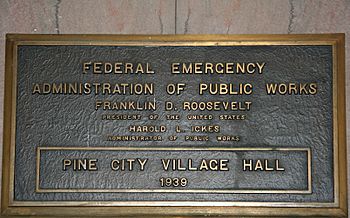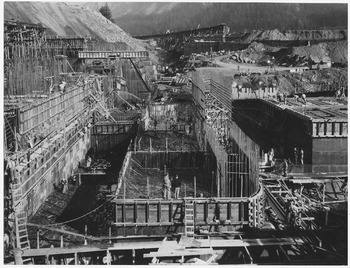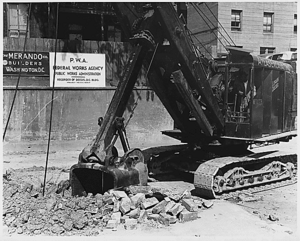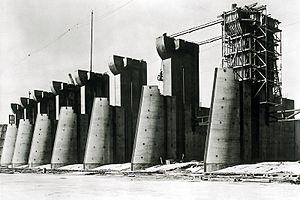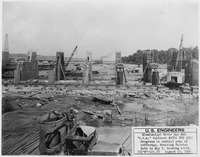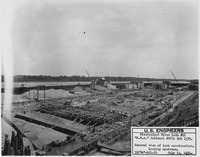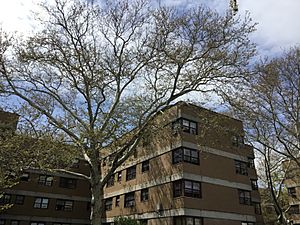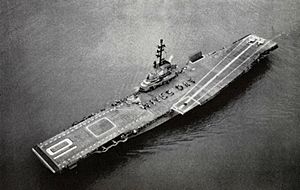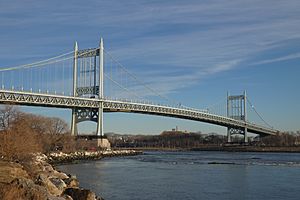Public Works Administration facts for kids
The Public Works Administration (PWA) was a big government agency in the United States. It was created in 1933 as part of the New Deal, a plan to help the country during the Great Depression. The PWA built many large projects like dams, bridges, hospitals, and schools.
Its main goals were to create jobs and help the economy recover. The PWA spent over $7 billion (a huge amount back then!) on building projects. These projects were done by private construction companies. The PWA built important structures that are still used today, even after more than 90 years. It was different from another New Deal agency, the Works Progress Administration (WPA), which focused on smaller projects and hired unemployed people directly.
Contents
Why the PWA Was Created
The PWA was started to help the U.S. economy get better after the Great Depression. A big problem was that many people didn't have jobs. About 24% of all workers were unemployed. The PWA wanted to lower this number.
It also aimed to help people have more money to spend. It did this by building new public buildings and roads. Important people like Frances Perkins and Harold L. Ickes supported the idea. President Franklin Delano Roosevelt agreed to make the PWA part of his New Deal plans in 1933.
What the PWA Built
The PWA planned projects from its main office in Washington, D.C. Private construction companies then built these projects. These companies hired workers from the regular job market. The PWA did not hire people who were unemployed directly, unlike the WPA.
From 1933 to 1939, the PWA helped build more than 34,000 projects. These included airports, large dams that made electricity, and even major warships for the Navy. It also built 70% of all new schools and one-third of all hospitals during that time.
Roads and highways were the most common PWA projects. About one-third of all PWA projects were roads. School buildings were the second most common, making up 14% of the spending. The PWA gave money to federal agencies and also gave loans and grants to states and local governments. For example, it helped build roads and bridges on Native American reservations.
The PWA became a huge force in American construction. It had a budget of $3.3 billion in its first two years. This was a lot of money compared to the country's total economic output at the time. By 1934, the PWA had given out all its money for thousands of projects. For every worker on a PWA project, almost two more workers got jobs indirectly.
The PWA helped bring electricity to rural areas. It also built canals, tunnels, bridges, highways, and sewage systems. It built housing areas, hospitals, schools, and universities. Every year, it used about half of all the concrete and one-third of all the steel made in the U.S. The PWA even helped electrify the Pennsylvania Railroad between New York City and Washington, D.C. Many of the courthouses, schools, and hospitals it built are still used today.
Famous PWA Projects
Some of the most well-known projects include:
- The Bankhead Tunnel in Mobile, Alabama.
- The Lincoln Tunnel in New York City.
Major Bridges
- Bourne Bridge
- Cape Cod Canal Railroad Bridge
- Overseas Highway connecting Key West, Florida, to the mainland.
- Sagamore Bridge
- Triborough Bridge (now the Robert F. Kennedy Bridge).
Important Dams
- Fort Peck Dam
- Grand Coulee Dam in Washington state.
- Hoover Dam
- Mansfield Dam
- Pensacola Dam
- Tom Miller Dam
- Many locks and dams along the Upper Mississippi River.
Key Airports
The PWA helped build or improve many major airports, including:
- Charlotte Douglas International Airport
- Hartsfield–Jackson Atlanta International Airport
- Los Angeles International Airport
- Logan International Airport in Boston.
- Philadelphia International Airport
Housing Projects
The PWA was meant to be a big part of the New Deal's plan to build public housing for people in cities who needed it. Public housing was a new idea in the U.S. at that time. The PWA built 52 housing communities with a total of 29,000 homes.
One of the first public housing communities built by the PWA was the Techwood Homes in Atlanta, Georgia. The PWA also built the Williamsburg Houses in Brooklyn, New York City.
End of the PWA
As the U.S. got ready for World War II, President Roosevelt changed how industries worked. The PWA was officially ended in 1943. Its jobs were moved to another agency.
The PWA helped the war effort indirectly. It helped fund the building of two important aircraft carriers, the USS Yorktown and the USS Enterprise. These ships were very important in the victory at Midway, where they sank four Japanese aircraft carriers. The PWA also helped build other Navy ships like cruisers, destroyers, and submarines. It even helped make planes, engines, and instruments for these vessels. The PWA's work helped the U.S. prepare for World War II with new ships, planes, and equipment.
PWA's Lasting Impact
The PWA built about 34,000 buildings, bridges, and homes. Many of these are still used today. One famous example is the Triborough Bridge in New York City. The PWA also funded the San Francisco Mint and helped repair the Keys Overseas Highway in Florida. This highway had been badly damaged by a hurricane, and the PWA's help made it usable again.
A big reason why so many PWA projects are still around is that the PWA let state and local governments choose what they wanted to build or fix. They also decided where the project would be and who would build it. This freedom meant that local governments could pick truly useful buildings that would be helpful for many years.
PWA vs. WPA
It's easy to confuse the PWA with the Works Progress Administration (WPA), but they were different. Both were part of the New Deal, but they had different ways of working.
- The WPA, led by Harry Hopkins, focused on smaller projects. These included things like building city halls, sewers, or sidewalks.
- The PWA projects were much bigger, like giant dams.
- The WPA hired people who were unemployed directly and paid them with federal money.
- The PWA gave contracts to private companies. These companies then hired workers from the regular job market.
- The WPA also had special programs for young people, women, and artists. The PWA did not have these types of programs.


